Operations and Project Management: Clark International & Portakabin
VerifiedAdded on 2023/01/19
|19
|4571
|21
Project
AI Summary
This project delves into the realms of operations and project management, offering a comprehensive analysis of key principles and their practical application. The first part of the project focuses on Clark International Ltd, a shoe manufacturing company. It examines the effectiveness of operations management principles, including variance, quality control, and organizational structure, in addressing challenges such as cost reduction, quality improvement, and delivery efficiency. A continuous improvement plan is proposed, incorporating lean principles to enhance productivity and customer satisfaction. The second part of the project shifts to project management, using Portakabin, a modular building innovator, as a case study. It explores the project life cycle, work breakdown structure, and Gantt charts. The project then delves into theoretical and conceptual arguments to justify the use of project methodologies, tools, and leadership within the given project. It also reviews and critiques the effectiveness of the project life cycle, highlighting the importance of designing and implementing it effectively, incorporating cost-saving techniques, and ensuring quality, scope, and tenure. The project concludes with an evaluation of the generated project life cycle, providing valuable insights into the application of project management principles in real-world scenarios.
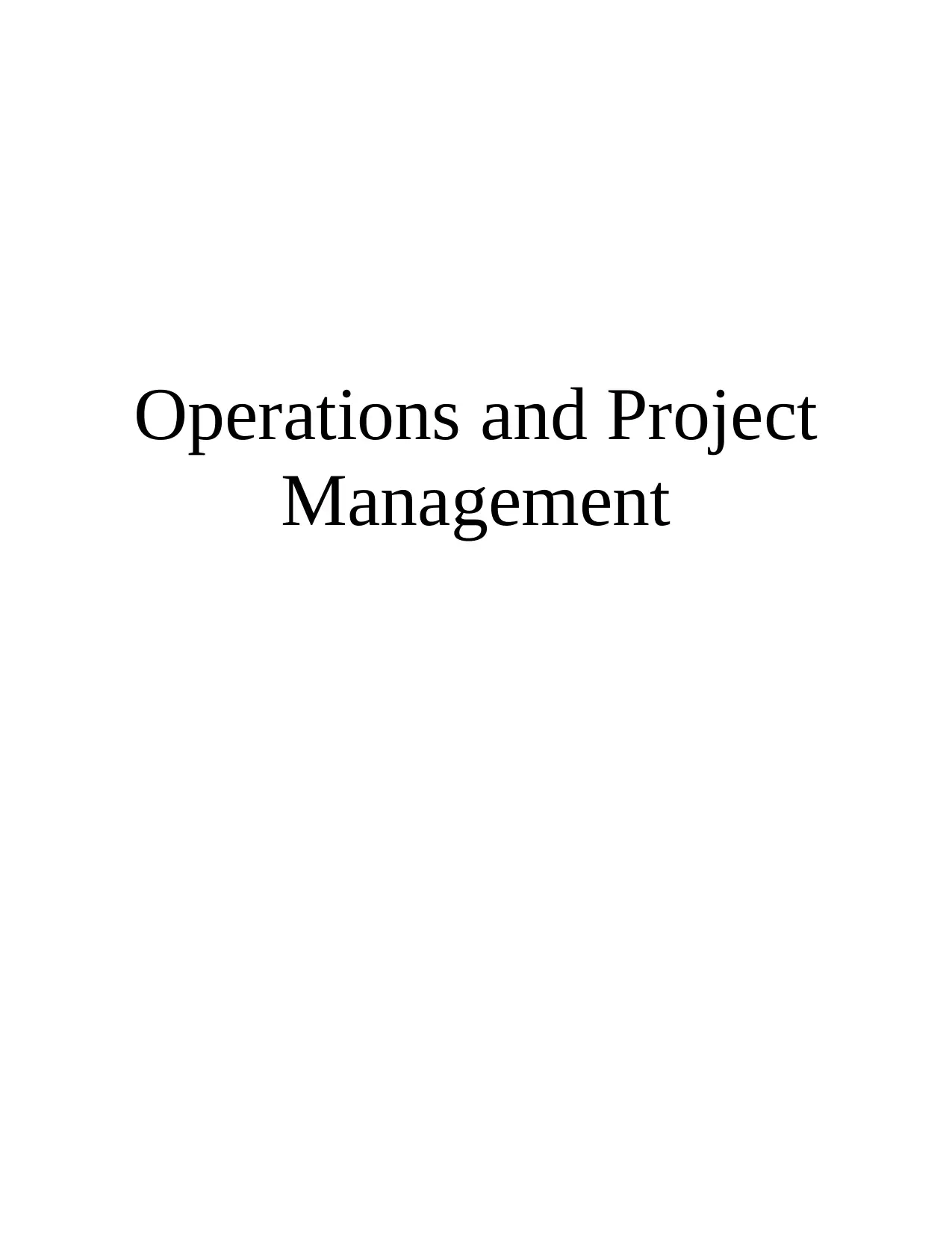
Operations and Project
Management
Management
Paraphrase This Document
Need a fresh take? Get an instant paraphrase of this document with our AI Paraphraser
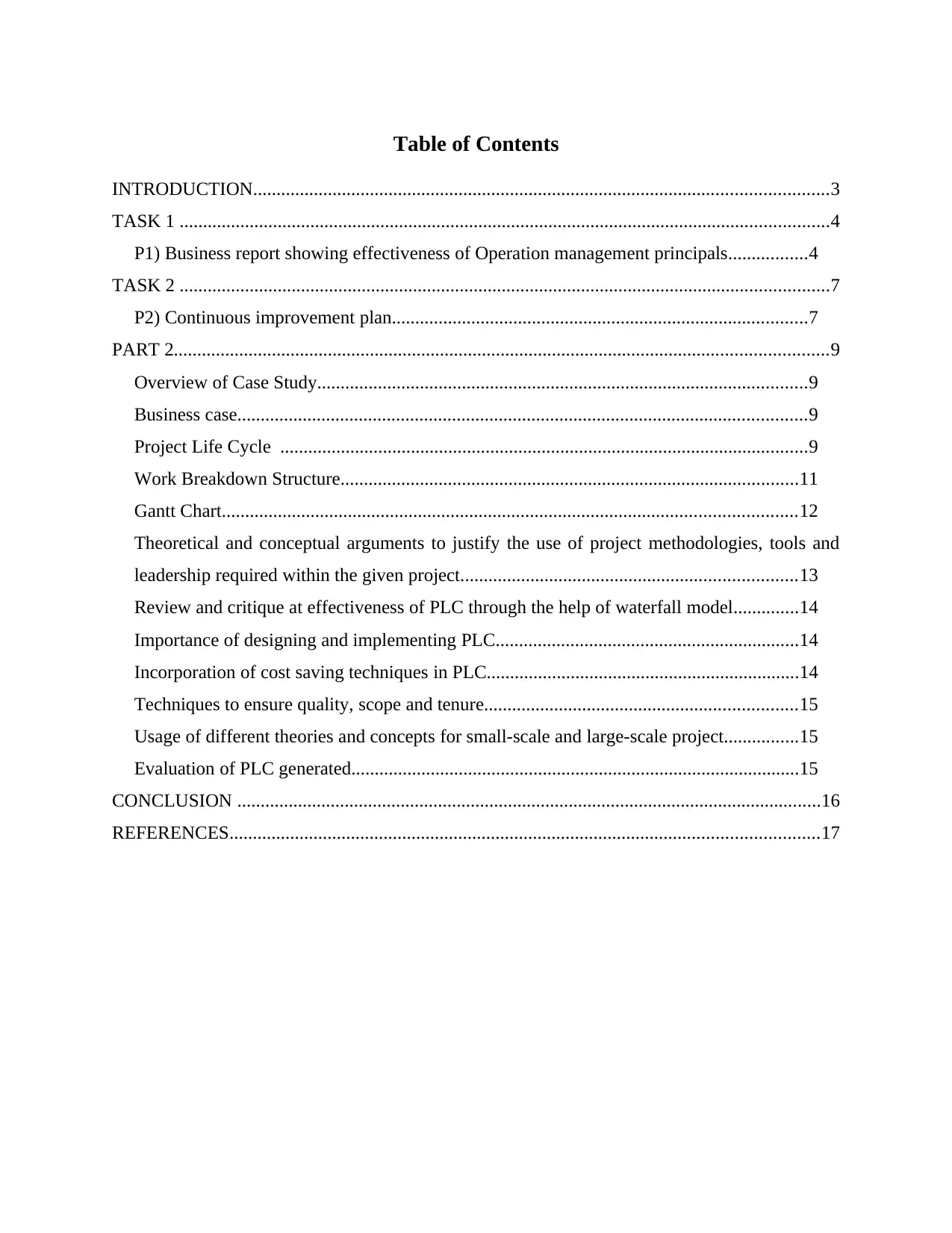
Table of Contents
INTRODUCTION...........................................................................................................................3
TASK 1 ...........................................................................................................................................4
P1) Business report showing effectiveness of Operation management principals.................4
TASK 2 ...........................................................................................................................................7
P2) Continuous improvement plan.........................................................................................7
PART 2............................................................................................................................................9
Overview of Case Study.........................................................................................................9
Business case..........................................................................................................................9
Project Life Cycle .................................................................................................................9
Work Breakdown Structure..................................................................................................11
Gantt Chart...........................................................................................................................12
Theoretical and conceptual arguments to justify the use of project methodologies, tools and
leadership required within the given project........................................................................13
Review and critique at effectiveness of PLC through the help of waterfall model..............14
Importance of designing and implementing PLC.................................................................14
Incorporation of cost saving techniques in PLC...................................................................14
Techniques to ensure quality, scope and tenure...................................................................15
Usage of different theories and concepts for small-scale and large-scale project................15
Evaluation of PLC generated................................................................................................15
CONCLUSION .............................................................................................................................16
REFERENCES..............................................................................................................................17
INTRODUCTION...........................................................................................................................3
TASK 1 ...........................................................................................................................................4
P1) Business report showing effectiveness of Operation management principals.................4
TASK 2 ...........................................................................................................................................7
P2) Continuous improvement plan.........................................................................................7
PART 2............................................................................................................................................9
Overview of Case Study.........................................................................................................9
Business case..........................................................................................................................9
Project Life Cycle .................................................................................................................9
Work Breakdown Structure..................................................................................................11
Gantt Chart...........................................................................................................................12
Theoretical and conceptual arguments to justify the use of project methodologies, tools and
leadership required within the given project........................................................................13
Review and critique at effectiveness of PLC through the help of waterfall model..............14
Importance of designing and implementing PLC.................................................................14
Incorporation of cost saving techniques in PLC...................................................................14
Techniques to ensure quality, scope and tenure...................................................................15
Usage of different theories and concepts for small-scale and large-scale project................15
Evaluation of PLC generated................................................................................................15
CONCLUSION .............................................................................................................................16
REFERENCES..............................................................................................................................17

⊘ This is a preview!⊘
Do you want full access?
Subscribe today to unlock all pages.

Trusted by 1+ million students worldwide
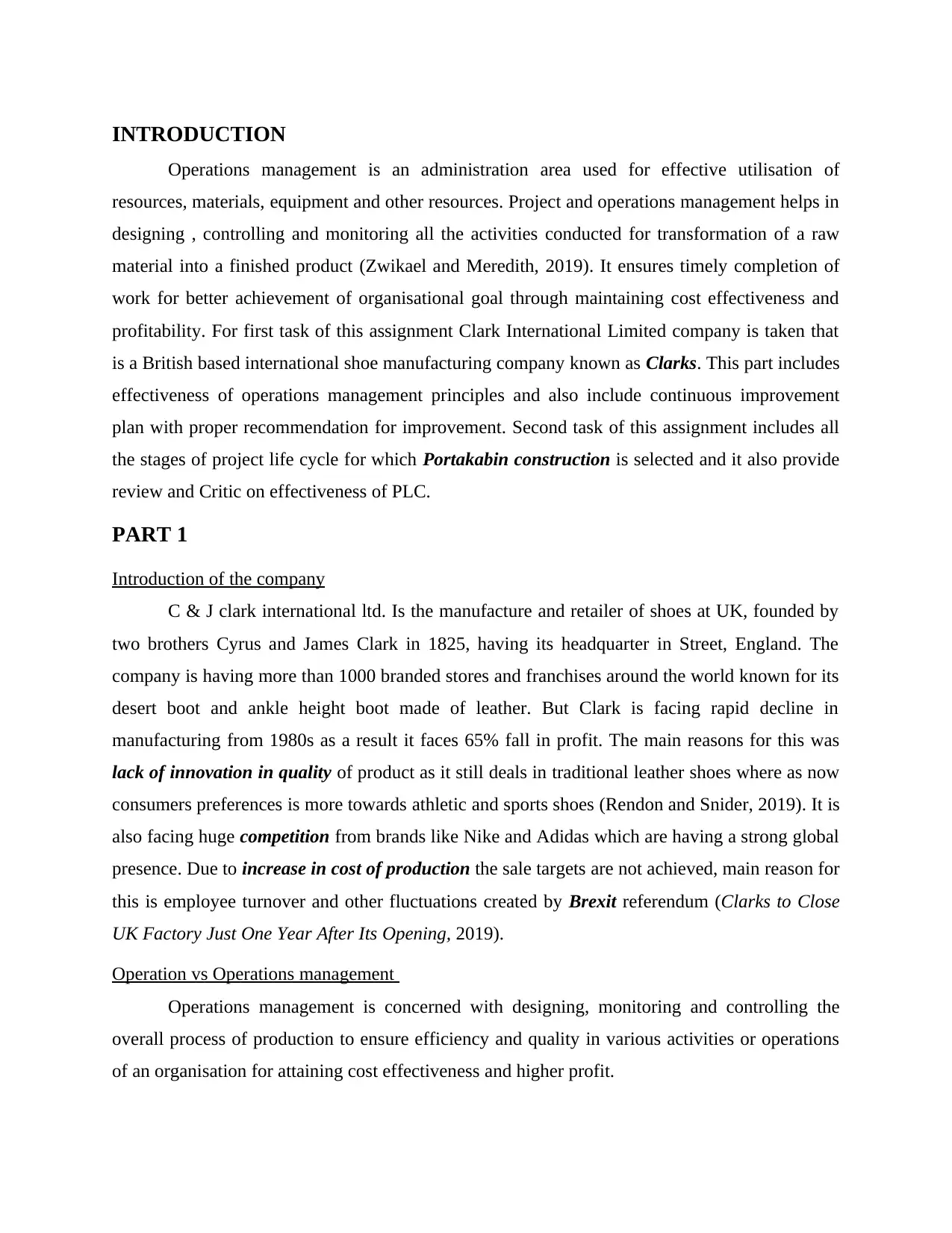
INTRODUCTION
Operations management is an administration area used for effective utilisation of
resources, materials, equipment and other resources. Project and operations management helps in
designing , controlling and monitoring all the activities conducted for transformation of a raw
material into a finished product (Zwikael and Meredith, 2019). It ensures timely completion of
work for better achievement of organisational goal through maintaining cost effectiveness and
profitability. For first task of this assignment Clark International Limited company is taken that
is a British based international shoe manufacturing company known as Clarks. This part includes
effectiveness of operations management principles and also include continuous improvement
plan with proper recommendation for improvement. Second task of this assignment includes all
the stages of project life cycle for which Portakabin construction is selected and it also provide
review and Critic on effectiveness of PLC.
PART 1
Introduction of the company
C & J clark international ltd. Is the manufacture and retailer of shoes at UK, founded by
two brothers Cyrus and James Clark in 1825, having its headquarter in Street, England. The
company is having more than 1000 branded stores and franchises around the world known for its
desert boot and ankle height boot made of leather. But Clark is facing rapid decline in
manufacturing from 1980s as a result it faces 65% fall in profit. The main reasons for this was
lack of innovation in quality of product as it still deals in traditional leather shoes where as now
consumers preferences is more towards athletic and sports shoes (Rendon and Snider, 2019). It is
also facing huge competition from brands like Nike and Adidas which are having a strong global
presence. Due to increase in cost of production the sale targets are not achieved, main reason for
this is employee turnover and other fluctuations created by Brexit referendum (Clarks to Close
UK Factory Just One Year After Its Opening, 2019).
Operation vs Operations management
Operations management is concerned with designing, monitoring and controlling the
overall process of production to ensure efficiency and quality in various activities or operations
of an organisation for attaining cost effectiveness and higher profit.
Operations management is an administration area used for effective utilisation of
resources, materials, equipment and other resources. Project and operations management helps in
designing , controlling and monitoring all the activities conducted for transformation of a raw
material into a finished product (Zwikael and Meredith, 2019). It ensures timely completion of
work for better achievement of organisational goal through maintaining cost effectiveness and
profitability. For first task of this assignment Clark International Limited company is taken that
is a British based international shoe manufacturing company known as Clarks. This part includes
effectiveness of operations management principles and also include continuous improvement
plan with proper recommendation for improvement. Second task of this assignment includes all
the stages of project life cycle for which Portakabin construction is selected and it also provide
review and Critic on effectiveness of PLC.
PART 1
Introduction of the company
C & J clark international ltd. Is the manufacture and retailer of shoes at UK, founded by
two brothers Cyrus and James Clark in 1825, having its headquarter in Street, England. The
company is having more than 1000 branded stores and franchises around the world known for its
desert boot and ankle height boot made of leather. But Clark is facing rapid decline in
manufacturing from 1980s as a result it faces 65% fall in profit. The main reasons for this was
lack of innovation in quality of product as it still deals in traditional leather shoes where as now
consumers preferences is more towards athletic and sports shoes (Rendon and Snider, 2019). It is
also facing huge competition from brands like Nike and Adidas which are having a strong global
presence. Due to increase in cost of production the sale targets are not achieved, main reason for
this is employee turnover and other fluctuations created by Brexit referendum (Clarks to Close
UK Factory Just One Year After Its Opening, 2019).
Operation vs Operations management
Operations management is concerned with designing, monitoring and controlling the
overall process of production to ensure efficiency and quality in various activities or operations
of an organisation for attaining cost effectiveness and higher profit.
Paraphrase This Document
Need a fresh take? Get an instant paraphrase of this document with our AI Paraphraser
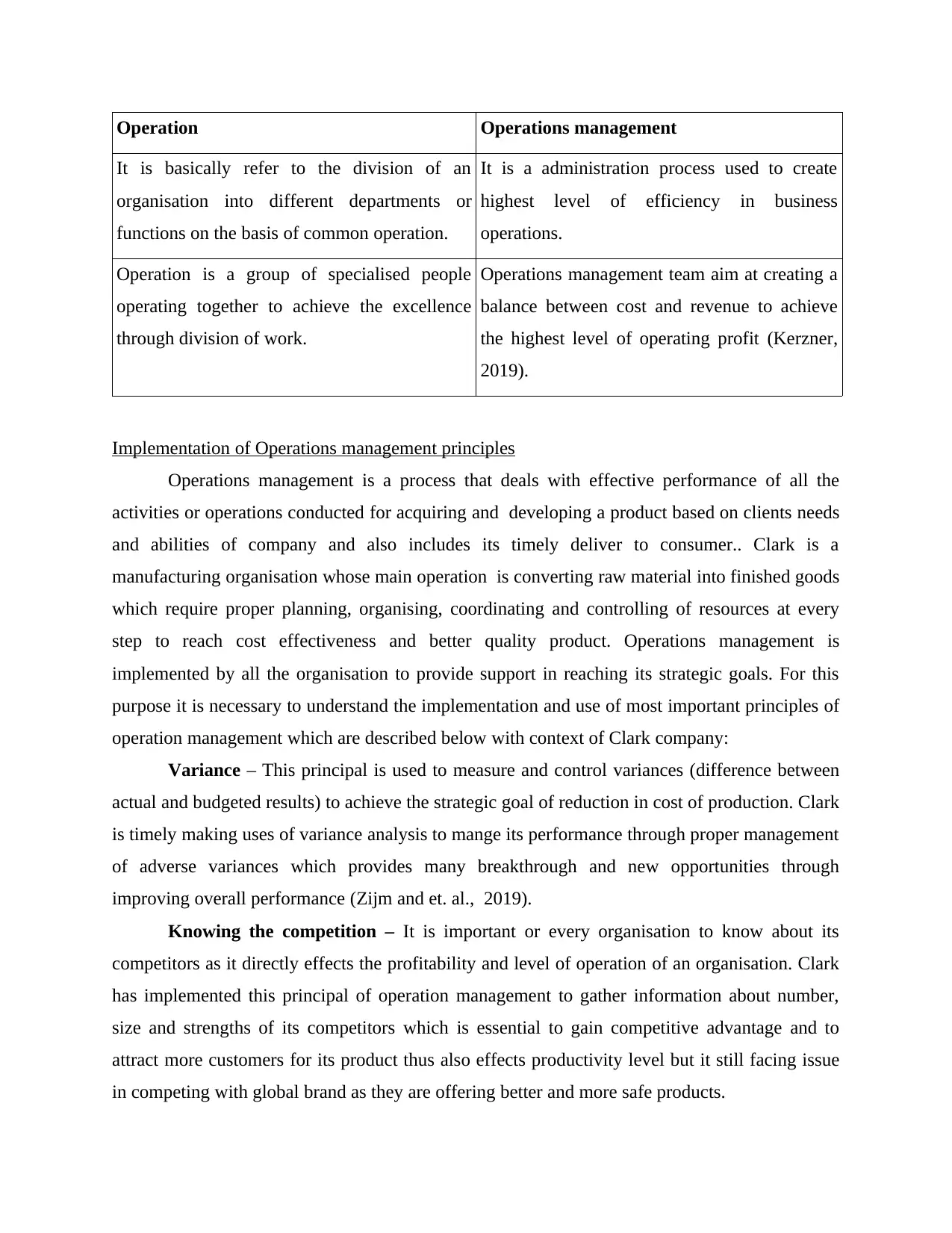
Operation Operations management
It is basically refer to the division of an
organisation into different departments or
functions on the basis of common operation.
It is a administration process used to create
highest level of efficiency in business
operations.
Operation is a group of specialised people
operating together to achieve the excellence
through division of work.
Operations management team aim at creating a
balance between cost and revenue to achieve
the highest level of operating profit (Kerzner,
2019).
Implementation of Operations management principles
Operations management is a process that deals with effective performance of all the
activities or operations conducted for acquiring and developing a product based on clients needs
and abilities of company and also includes its timely deliver to consumer.. Clark is a
manufacturing organisation whose main operation is converting raw material into finished goods
which require proper planning, organising, coordinating and controlling of resources at every
step to reach cost effectiveness and better quality product. Operations management is
implemented by all the organisation to provide support in reaching its strategic goals. For this
purpose it is necessary to understand the implementation and use of most important principles of
operation management which are described below with context of Clark company:
Variance – This principal is used to measure and control variances (difference between
actual and budgeted results) to achieve the strategic goal of reduction in cost of production. Clark
is timely making uses of variance analysis to mange its performance through proper management
of adverse variances which provides many breakthrough and new opportunities through
improving overall performance (Zijm and et. al., 2019).
Knowing the competition – It is important or every organisation to know about its
competitors as it directly effects the profitability and level of operation of an organisation. Clark
has implemented this principal of operation management to gather information about number,
size and strengths of its competitors which is essential to gain competitive advantage and to
attract more customers for its product thus also effects productivity level but it still facing issue
in competing with global brand as they are offering better and more safe products.
It is basically refer to the division of an
organisation into different departments or
functions on the basis of common operation.
It is a administration process used to create
highest level of efficiency in business
operations.
Operation is a group of specialised people
operating together to achieve the excellence
through division of work.
Operations management team aim at creating a
balance between cost and revenue to achieve
the highest level of operating profit (Kerzner,
2019).
Implementation of Operations management principles
Operations management is a process that deals with effective performance of all the
activities or operations conducted for acquiring and developing a product based on clients needs
and abilities of company and also includes its timely deliver to consumer.. Clark is a
manufacturing organisation whose main operation is converting raw material into finished goods
which require proper planning, organising, coordinating and controlling of resources at every
step to reach cost effectiveness and better quality product. Operations management is
implemented by all the organisation to provide support in reaching its strategic goals. For this
purpose it is necessary to understand the implementation and use of most important principles of
operation management which are described below with context of Clark company:
Variance – This principal is used to measure and control variances (difference between
actual and budgeted results) to achieve the strategic goal of reduction in cost of production. Clark
is timely making uses of variance analysis to mange its performance through proper management
of adverse variances which provides many breakthrough and new opportunities through
improving overall performance (Zijm and et. al., 2019).
Knowing the competition – It is important or every organisation to know about its
competitors as it directly effects the profitability and level of operation of an organisation. Clark
has implemented this principal of operation management to gather information about number,
size and strengths of its competitors which is essential to gain competitive advantage and to
attract more customers for its product thus also effects productivity level but it still facing issue
in competing with global brand as they are offering better and more safe products.
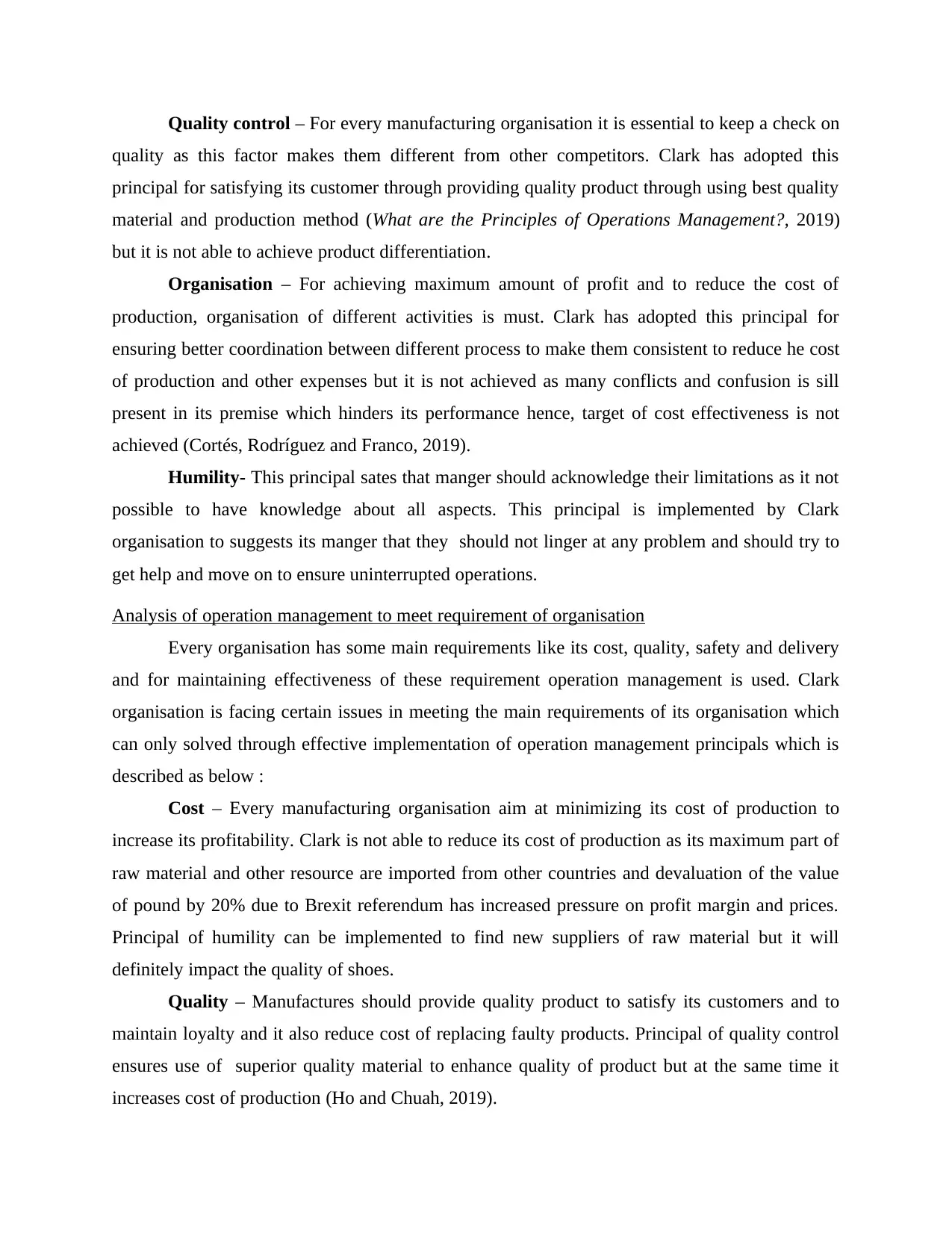
Quality control – For every manufacturing organisation it is essential to keep a check on
quality as this factor makes them different from other competitors. Clark has adopted this
principal for satisfying its customer through providing quality product through using best quality
material and production method (What are the Principles of Operations Management?, 2019)
but it is not able to achieve product differentiation.
Organisation – For achieving maximum amount of profit and to reduce the cost of
production, organisation of different activities is must. Clark has adopted this principal for
ensuring better coordination between different process to make them consistent to reduce he cost
of production and other expenses but it is not achieved as many conflicts and confusion is sill
present in its premise which hinders its performance hence, target of cost effectiveness is not
achieved (Cortés, Rodríguez and Franco, 2019).
Humility- This principal sates that manger should acknowledge their limitations as it not
possible to have knowledge about all aspects. This principal is implemented by Clark
organisation to suggests its manger that they should not linger at any problem and should try to
get help and move on to ensure uninterrupted operations.
Analysis of operation management to meet requirement of organisation
Every organisation has some main requirements like its cost, quality, safety and delivery
and for maintaining effectiveness of these requirement operation management is used. Clark
organisation is facing certain issues in meeting the main requirements of its organisation which
can only solved through effective implementation of operation management principals which is
described as below :
Cost – Every manufacturing organisation aim at minimizing its cost of production to
increase its profitability. Clark is not able to reduce its cost of production as its maximum part of
raw material and other resource are imported from other countries and devaluation of the value
of pound by 20% due to Brexit referendum has increased pressure on profit margin and prices.
Principal of humility can be implemented to find new suppliers of raw material but it will
definitely impact the quality of shoes.
Quality – Manufactures should provide quality product to satisfy its customers and to
maintain loyalty and it also reduce cost of replacing faulty products. Principal of quality control
ensures use of superior quality material to enhance quality of product but at the same time it
increases cost of production (Ho and Chuah, 2019).
quality as this factor makes them different from other competitors. Clark has adopted this
principal for satisfying its customer through providing quality product through using best quality
material and production method (What are the Principles of Operations Management?, 2019)
but it is not able to achieve product differentiation.
Organisation – For achieving maximum amount of profit and to reduce the cost of
production, organisation of different activities is must. Clark has adopted this principal for
ensuring better coordination between different process to make them consistent to reduce he cost
of production and other expenses but it is not achieved as many conflicts and confusion is sill
present in its premise which hinders its performance hence, target of cost effectiveness is not
achieved (Cortés, Rodríguez and Franco, 2019).
Humility- This principal sates that manger should acknowledge their limitations as it not
possible to have knowledge about all aspects. This principal is implemented by Clark
organisation to suggests its manger that they should not linger at any problem and should try to
get help and move on to ensure uninterrupted operations.
Analysis of operation management to meet requirement of organisation
Every organisation has some main requirements like its cost, quality, safety and delivery
and for maintaining effectiveness of these requirement operation management is used. Clark
organisation is facing certain issues in meeting the main requirements of its organisation which
can only solved through effective implementation of operation management principals which is
described as below :
Cost – Every manufacturing organisation aim at minimizing its cost of production to
increase its profitability. Clark is not able to reduce its cost of production as its maximum part of
raw material and other resource are imported from other countries and devaluation of the value
of pound by 20% due to Brexit referendum has increased pressure on profit margin and prices.
Principal of humility can be implemented to find new suppliers of raw material but it will
definitely impact the quality of shoes.
Quality – Manufactures should provide quality product to satisfy its customers and to
maintain loyalty and it also reduce cost of replacing faulty products. Principal of quality control
ensures use of superior quality material to enhance quality of product but at the same time it
increases cost of production (Ho and Chuah, 2019).
⊘ This is a preview!⊘
Do you want full access?
Subscribe today to unlock all pages.

Trusted by 1+ million students worldwide
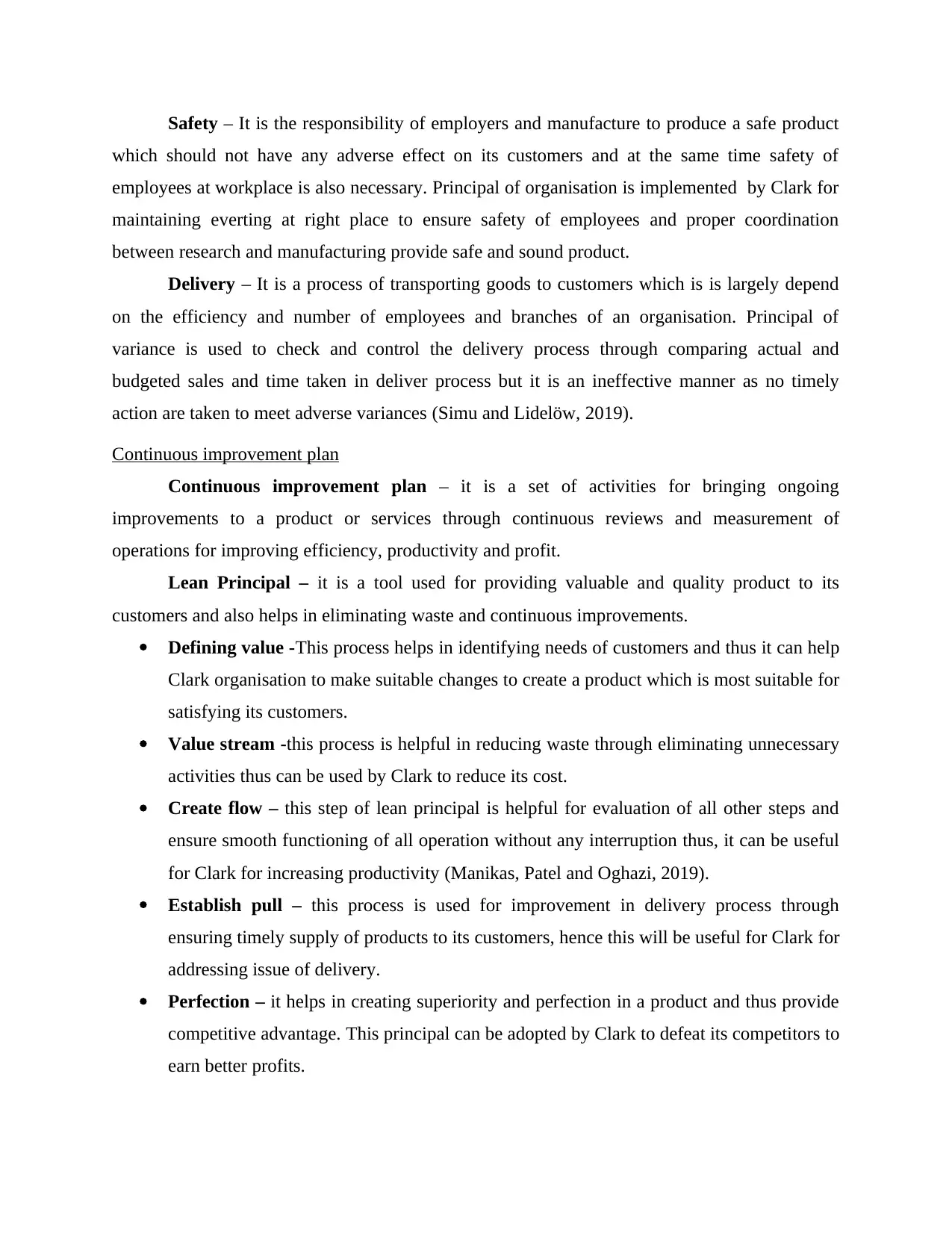
Safety – It is the responsibility of employers and manufacture to produce a safe product
which should not have any adverse effect on its customers and at the same time safety of
employees at workplace is also necessary. Principal of organisation is implemented by Clark for
maintaining everting at right place to ensure safety of employees and proper coordination
between research and manufacturing provide safe and sound product.
Delivery – It is a process of transporting goods to customers which is is largely depend
on the efficiency and number of employees and branches of an organisation. Principal of
variance is used to check and control the delivery process through comparing actual and
budgeted sales and time taken in deliver process but it is an ineffective manner as no timely
action are taken to meet adverse variances (Simu and Lidelöw, 2019).
Continuous improvement plan
Continuous improvement plan – it is a set of activities for bringing ongoing
improvements to a product or services through continuous reviews and measurement of
operations for improving efficiency, productivity and profit.
Lean Principal – it is a tool used for providing valuable and quality product to its
customers and also helps in eliminating waste and continuous improvements.
Defining value -This process helps in identifying needs of customers and thus it can help
Clark organisation to make suitable changes to create a product which is most suitable for
satisfying its customers.
Value stream -this process is helpful in reducing waste through eliminating unnecessary
activities thus can be used by Clark to reduce its cost.
Create flow – this step of lean principal is helpful for evaluation of all other steps and
ensure smooth functioning of all operation without any interruption thus, it can be useful
for Clark for increasing productivity (Manikas, Patel and Oghazi, 2019).
Establish pull – this process is used for improvement in delivery process through
ensuring timely supply of products to its customers, hence this will be useful for Clark for
addressing issue of delivery.
Perfection – it helps in creating superiority and perfection in a product and thus provide
competitive advantage. This principal can be adopted by Clark to defeat its competitors to
earn better profits.
which should not have any adverse effect on its customers and at the same time safety of
employees at workplace is also necessary. Principal of organisation is implemented by Clark for
maintaining everting at right place to ensure safety of employees and proper coordination
between research and manufacturing provide safe and sound product.
Delivery – It is a process of transporting goods to customers which is is largely depend
on the efficiency and number of employees and branches of an organisation. Principal of
variance is used to check and control the delivery process through comparing actual and
budgeted sales and time taken in deliver process but it is an ineffective manner as no timely
action are taken to meet adverse variances (Simu and Lidelöw, 2019).
Continuous improvement plan
Continuous improvement plan – it is a set of activities for bringing ongoing
improvements to a product or services through continuous reviews and measurement of
operations for improving efficiency, productivity and profit.
Lean Principal – it is a tool used for providing valuable and quality product to its
customers and also helps in eliminating waste and continuous improvements.
Defining value -This process helps in identifying needs of customers and thus it can help
Clark organisation to make suitable changes to create a product which is most suitable for
satisfying its customers.
Value stream -this process is helpful in reducing waste through eliminating unnecessary
activities thus can be used by Clark to reduce its cost.
Create flow – this step of lean principal is helpful for evaluation of all other steps and
ensure smooth functioning of all operation without any interruption thus, it can be useful
for Clark for increasing productivity (Manikas, Patel and Oghazi, 2019).
Establish pull – this process is used for improvement in delivery process through
ensuring timely supply of products to its customers, hence this will be useful for Clark for
addressing issue of delivery.
Perfection – it helps in creating superiority and perfection in a product and thus provide
competitive advantage. This principal can be adopted by Clark to defeat its competitors to
earn better profits.
Paraphrase This Document
Need a fresh take? Get an instant paraphrase of this document with our AI Paraphraser
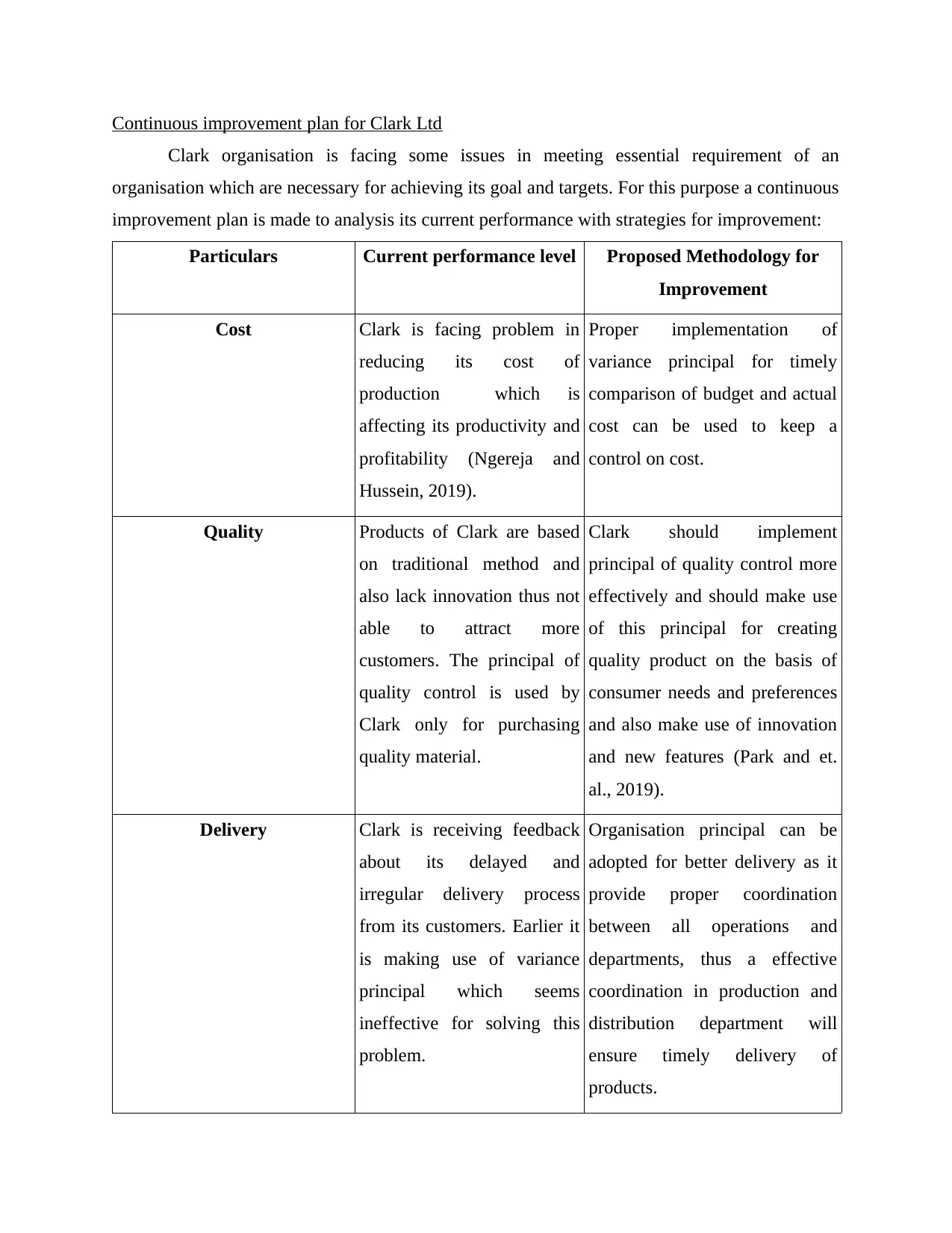
Continuous improvement plan for Clark Ltd
Clark organisation is facing some issues in meeting essential requirement of an
organisation which are necessary for achieving its goal and targets. For this purpose a continuous
improvement plan is made to analysis its current performance with strategies for improvement:
Particulars Current performance level Proposed Methodology for
Improvement
Cost Clark is facing problem in
reducing its cost of
production which is
affecting its productivity and
profitability (Ngereja and
Hussein, 2019).
Proper implementation of
variance principal for timely
comparison of budget and actual
cost can be used to keep a
control on cost.
Quality Products of Clark are based
on traditional method and
also lack innovation thus not
able to attract more
customers. The principal of
quality control is used by
Clark only for purchasing
quality material.
Clark should implement
principal of quality control more
effectively and should make use
of this principal for creating
quality product on the basis of
consumer needs and preferences
and also make use of innovation
and new features (Park and et.
al., 2019).
Delivery Clark is receiving feedback
about its delayed and
irregular delivery process
from its customers. Earlier it
is making use of variance
principal which seems
ineffective for solving this
problem.
Organisation principal can be
adopted for better delivery as it
provide proper coordination
between all operations and
departments, thus a effective
coordination in production and
distribution department will
ensure timely delivery of
products.
Clark organisation is facing some issues in meeting essential requirement of an
organisation which are necessary for achieving its goal and targets. For this purpose a continuous
improvement plan is made to analysis its current performance with strategies for improvement:
Particulars Current performance level Proposed Methodology for
Improvement
Cost Clark is facing problem in
reducing its cost of
production which is
affecting its productivity and
profitability (Ngereja and
Hussein, 2019).
Proper implementation of
variance principal for timely
comparison of budget and actual
cost can be used to keep a
control on cost.
Quality Products of Clark are based
on traditional method and
also lack innovation thus not
able to attract more
customers. The principal of
quality control is used by
Clark only for purchasing
quality material.
Clark should implement
principal of quality control more
effectively and should make use
of this principal for creating
quality product on the basis of
consumer needs and preferences
and also make use of innovation
and new features (Park and et.
al., 2019).
Delivery Clark is receiving feedback
about its delayed and
irregular delivery process
from its customers. Earlier it
is making use of variance
principal which seems
ineffective for solving this
problem.
Organisation principal can be
adopted for better delivery as it
provide proper coordination
between all operations and
departments, thus a effective
coordination in production and
distribution department will
ensure timely delivery of
products.
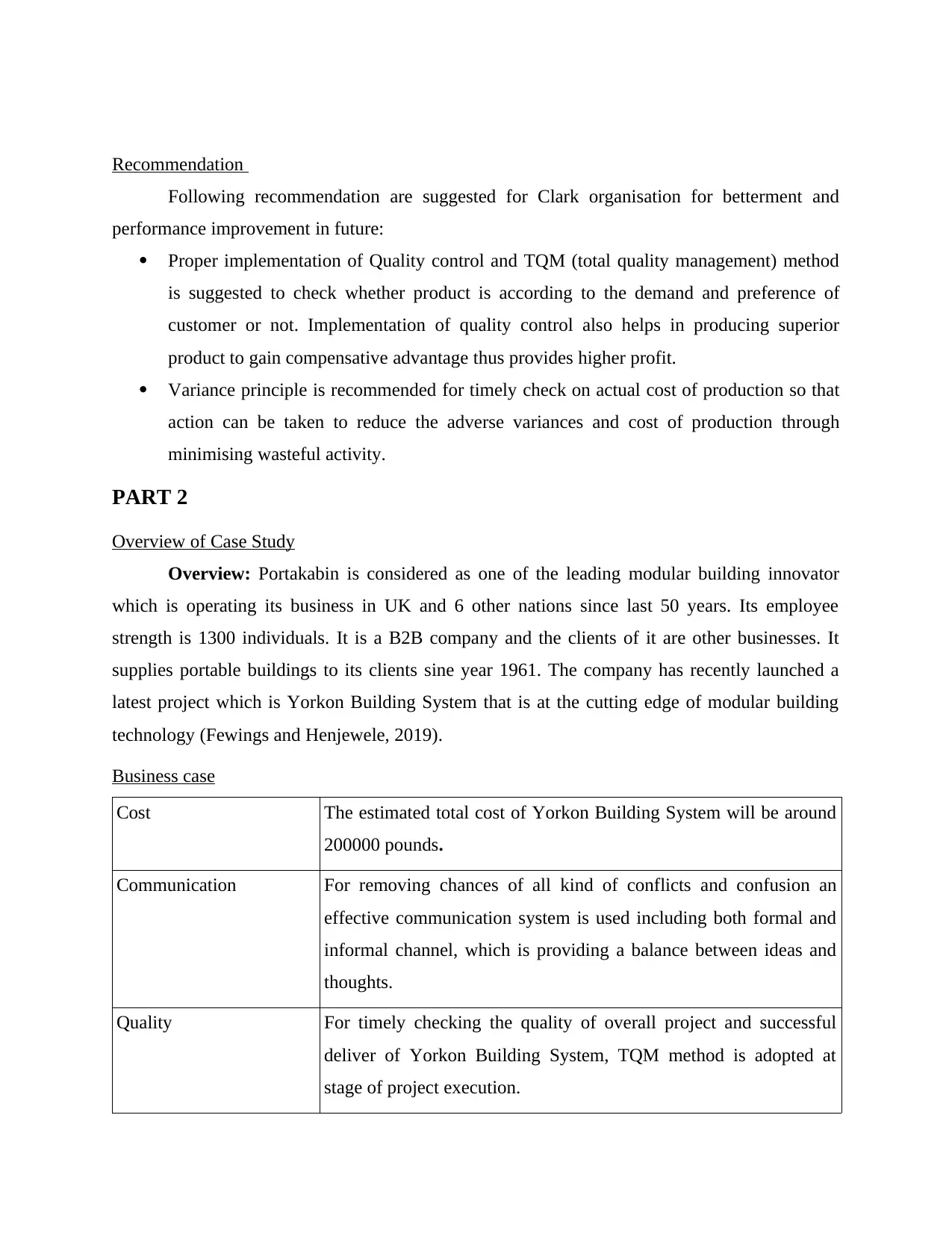
Recommendation
Following recommendation are suggested for Clark organisation for betterment and
performance improvement in future:
Proper implementation of Quality control and TQM (total quality management) method
is suggested to check whether product is according to the demand and preference of
customer or not. Implementation of quality control also helps in producing superior
product to gain compensative advantage thus provides higher profit.
Variance principle is recommended for timely check on actual cost of production so that
action can be taken to reduce the adverse variances and cost of production through
minimising wasteful activity.
PART 2
Overview of Case Study
Overview: Portakabin is considered as one of the leading modular building innovator
which is operating its business in UK and 6 other nations since last 50 years. Its employee
strength is 1300 individuals. It is a B2B company and the clients of it are other businesses. It
supplies portable buildings to its clients sine year 1961. The company has recently launched a
latest project which is Yorkon Building System that is at the cutting edge of modular building
technology (Fewings and Henjewele, 2019).
Business case
Cost The estimated total cost of Yorkon Building System will be around
200000 pounds.
Communication For removing chances of all kind of conflicts and confusion an
effective communication system is used including both formal and
informal channel, which is providing a balance between ideas and
thoughts.
Quality For timely checking the quality of overall project and successful
deliver of Yorkon Building System, TQM method is adopted at
stage of project execution.
Following recommendation are suggested for Clark organisation for betterment and
performance improvement in future:
Proper implementation of Quality control and TQM (total quality management) method
is suggested to check whether product is according to the demand and preference of
customer or not. Implementation of quality control also helps in producing superior
product to gain compensative advantage thus provides higher profit.
Variance principle is recommended for timely check on actual cost of production so that
action can be taken to reduce the adverse variances and cost of production through
minimising wasteful activity.
PART 2
Overview of Case Study
Overview: Portakabin is considered as one of the leading modular building innovator
which is operating its business in UK and 6 other nations since last 50 years. Its employee
strength is 1300 individuals. It is a B2B company and the clients of it are other businesses. It
supplies portable buildings to its clients sine year 1961. The company has recently launched a
latest project which is Yorkon Building System that is at the cutting edge of modular building
technology (Fewings and Henjewele, 2019).
Business case
Cost The estimated total cost of Yorkon Building System will be around
200000 pounds.
Communication For removing chances of all kind of conflicts and confusion an
effective communication system is used including both formal and
informal channel, which is providing a balance between ideas and
thoughts.
Quality For timely checking the quality of overall project and successful
deliver of Yorkon Building System, TQM method is adopted at
stage of project execution.
⊘ This is a preview!⊘
Do you want full access?
Subscribe today to unlock all pages.

Trusted by 1+ million students worldwide
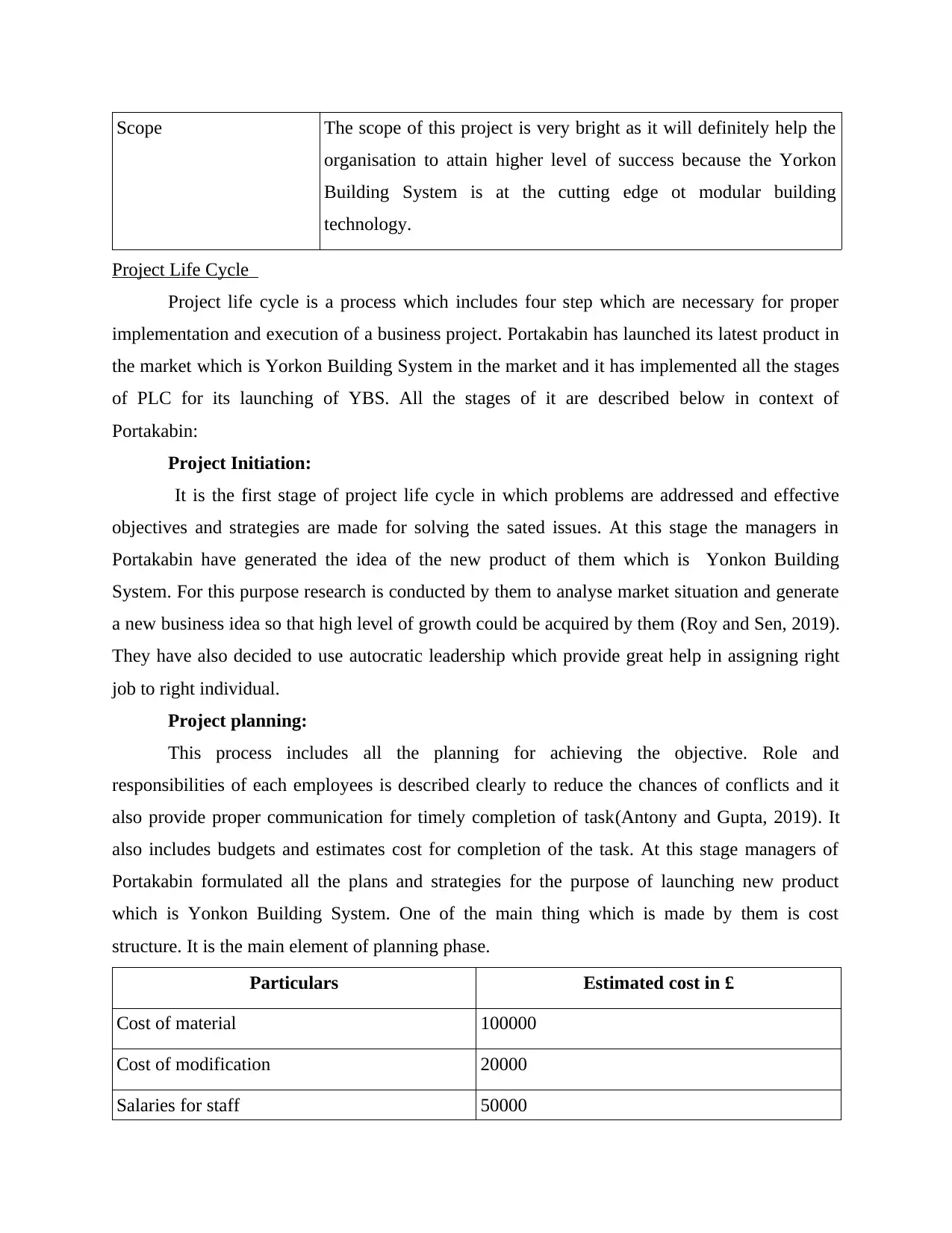
Scope The scope of this project is very bright as it will definitely help the
organisation to attain higher level of success because the Yorkon
Building System is at the cutting edge ot modular building
technology.
Project Life Cycle
Project life cycle is a process which includes four step which are necessary for proper
implementation and execution of a business project. Portakabin has launched its latest product in
the market which is Yorkon Building System in the market and it has implemented all the stages
of PLC for its launching of YBS. All the stages of it are described below in context of
Portakabin:
Project Initiation:
It is the first stage of project life cycle in which problems are addressed and effective
objectives and strategies are made for solving the sated issues. At this stage the managers in
Portakabin have generated the idea of the new product of them which is Yonkon Building
System. For this purpose research is conducted by them to analyse market situation and generate
a new business idea so that high level of growth could be acquired by them (Roy and Sen, 2019).
They have also decided to use autocratic leadership which provide great help in assigning right
job to right individual.
Project planning:
This process includes all the planning for achieving the objective. Role and
responsibilities of each employees is described clearly to reduce the chances of conflicts and it
also provide proper communication for timely completion of task(Antony and Gupta, 2019). It
also includes budgets and estimates cost for completion of the task. At this stage managers of
Portakabin formulated all the plans and strategies for the purpose of launching new product
which is Yonkon Building System. One of the main thing which is made by them is cost
structure. It is the main element of planning phase.
Particulars Estimated cost in £
Cost of material 100000
Cost of modification 20000
Salaries for staff 50000
organisation to attain higher level of success because the Yorkon
Building System is at the cutting edge ot modular building
technology.
Project Life Cycle
Project life cycle is a process which includes four step which are necessary for proper
implementation and execution of a business project. Portakabin has launched its latest product in
the market which is Yorkon Building System in the market and it has implemented all the stages
of PLC for its launching of YBS. All the stages of it are described below in context of
Portakabin:
Project Initiation:
It is the first stage of project life cycle in which problems are addressed and effective
objectives and strategies are made for solving the sated issues. At this stage the managers in
Portakabin have generated the idea of the new product of them which is Yonkon Building
System. For this purpose research is conducted by them to analyse market situation and generate
a new business idea so that high level of growth could be acquired by them (Roy and Sen, 2019).
They have also decided to use autocratic leadership which provide great help in assigning right
job to right individual.
Project planning:
This process includes all the planning for achieving the objective. Role and
responsibilities of each employees is described clearly to reduce the chances of conflicts and it
also provide proper communication for timely completion of task(Antony and Gupta, 2019). It
also includes budgets and estimates cost for completion of the task. At this stage managers of
Portakabin formulated all the plans and strategies for the purpose of launching new product
which is Yonkon Building System. One of the main thing which is made by them is cost
structure. It is the main element of planning phase.
Particulars Estimated cost in £
Cost of material 100000
Cost of modification 20000
Salaries for staff 50000
Paraphrase This Document
Need a fresh take? Get an instant paraphrase of this document with our AI Paraphraser
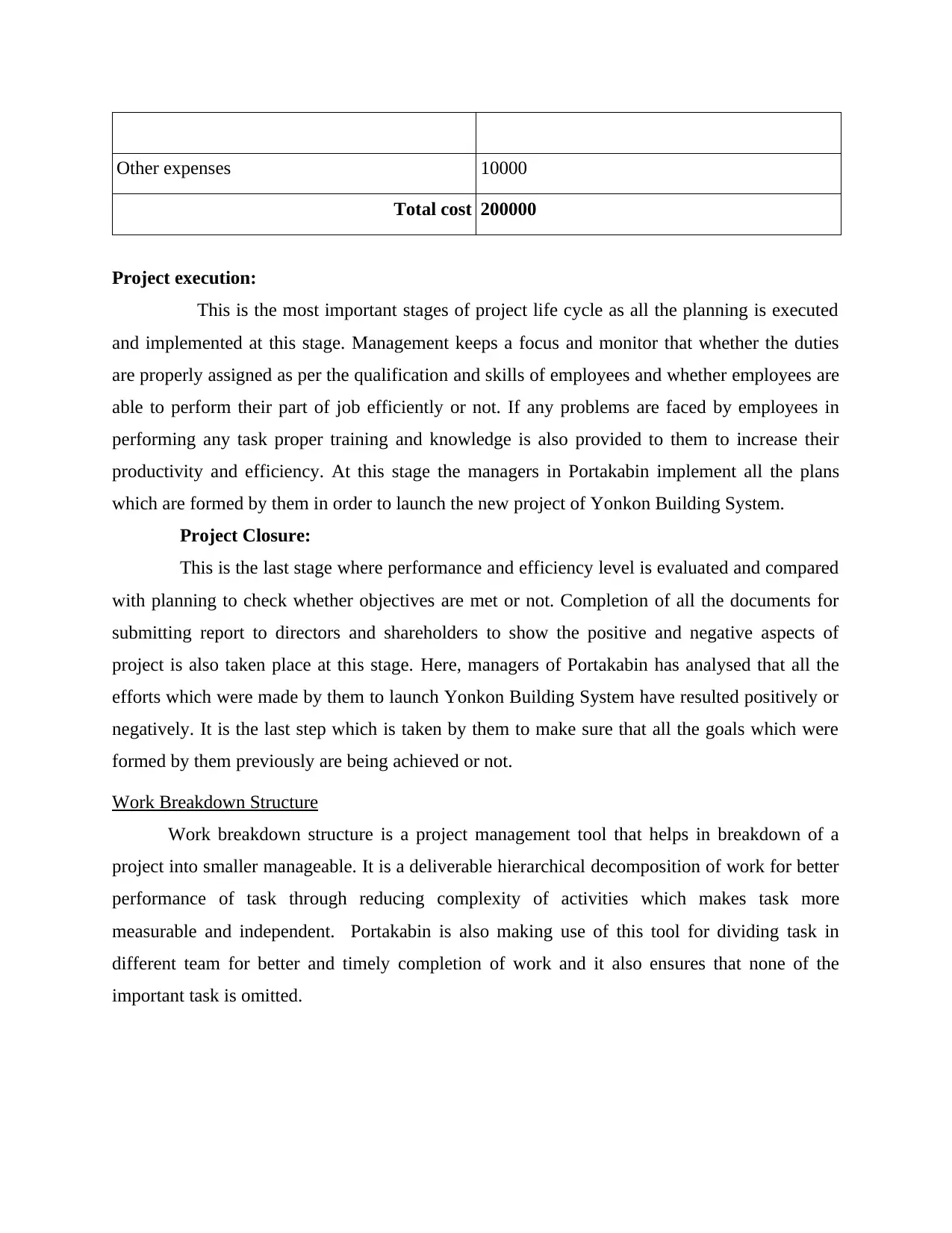
Other expenses 10000
Total cost 200000
Project execution:
This is the most important stages of project life cycle as all the planning is executed
and implemented at this stage. Management keeps a focus and monitor that whether the duties
are properly assigned as per the qualification and skills of employees and whether employees are
able to perform their part of job efficiently or not. If any problems are faced by employees in
performing any task proper training and knowledge is also provided to them to increase their
productivity and efficiency. At this stage the managers in Portakabin implement all the plans
which are formed by them in order to launch the new project of Yonkon Building System.
Project Closure:
This is the last stage where performance and efficiency level is evaluated and compared
with planning to check whether objectives are met or not. Completion of all the documents for
submitting report to directors and shareholders to show the positive and negative aspects of
project is also taken place at this stage. Here, managers of Portakabin has analysed that all the
efforts which were made by them to launch Yonkon Building System have resulted positively or
negatively. It is the last step which is taken by them to make sure that all the goals which were
formed by them previously are being achieved or not.
Work Breakdown Structure
Work breakdown structure is a project management tool that helps in breakdown of a
project into smaller manageable. It is a deliverable hierarchical decomposition of work for better
performance of task through reducing complexity of activities which makes task more
measurable and independent. Portakabin is also making use of this tool for dividing task in
different team for better and timely completion of work and it also ensures that none of the
important task is omitted.
Total cost 200000
Project execution:
This is the most important stages of project life cycle as all the planning is executed
and implemented at this stage. Management keeps a focus and monitor that whether the duties
are properly assigned as per the qualification and skills of employees and whether employees are
able to perform their part of job efficiently or not. If any problems are faced by employees in
performing any task proper training and knowledge is also provided to them to increase their
productivity and efficiency. At this stage the managers in Portakabin implement all the plans
which are formed by them in order to launch the new project of Yonkon Building System.
Project Closure:
This is the last stage where performance and efficiency level is evaluated and compared
with planning to check whether objectives are met or not. Completion of all the documents for
submitting report to directors and shareholders to show the positive and negative aspects of
project is also taken place at this stage. Here, managers of Portakabin has analysed that all the
efforts which were made by them to launch Yonkon Building System have resulted positively or
negatively. It is the last step which is taken by them to make sure that all the goals which were
formed by them previously are being achieved or not.
Work Breakdown Structure
Work breakdown structure is a project management tool that helps in breakdown of a
project into smaller manageable. It is a deliverable hierarchical decomposition of work for better
performance of task through reducing complexity of activities which makes task more
measurable and independent. Portakabin is also making use of this tool for dividing task in
different team for better and timely completion of work and it also ensures that none of the
important task is omitted.
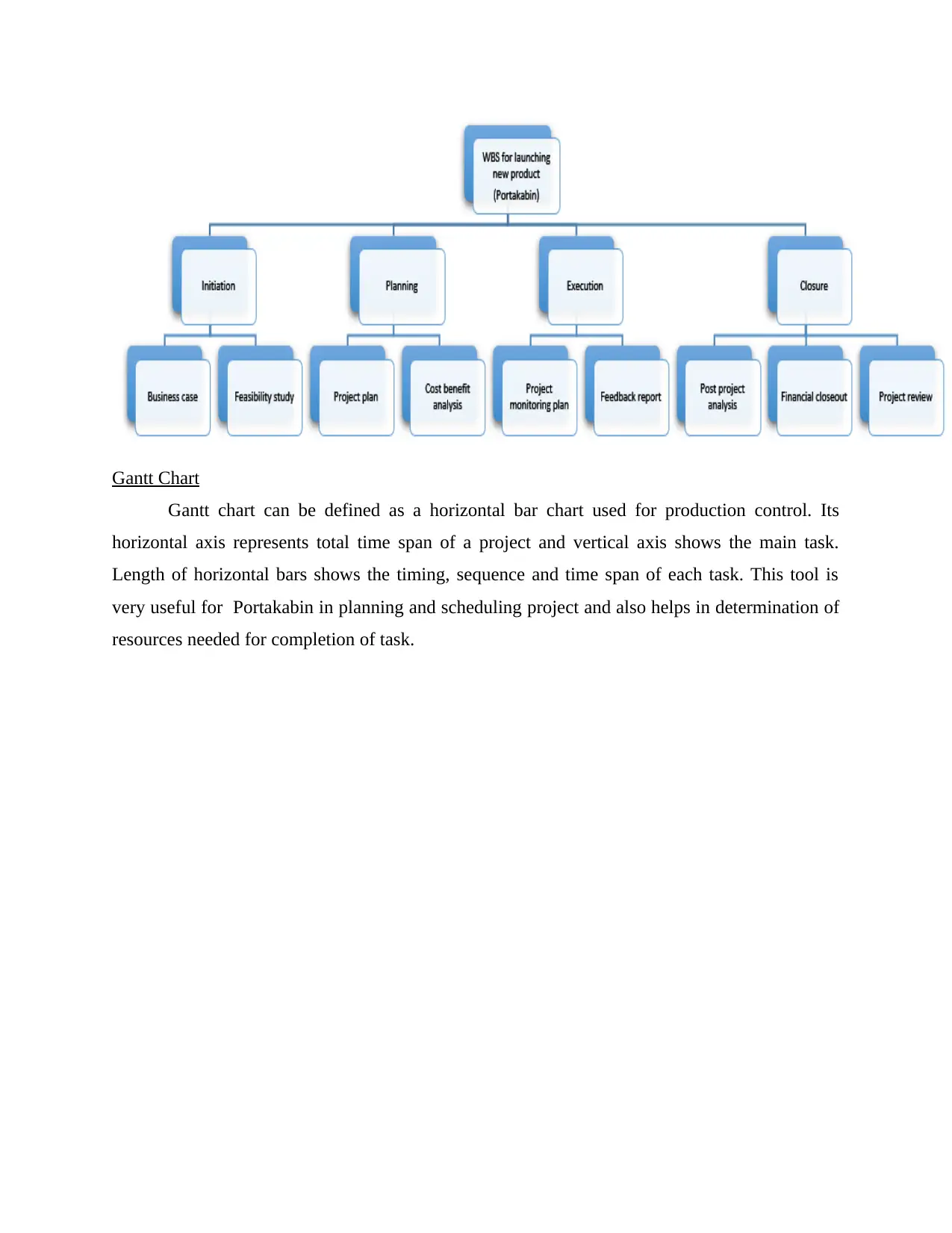
Gantt Chart
Gantt chart can be defined as a horizontal bar chart used for production control. Its
horizontal axis represents total time span of a project and vertical axis shows the main task.
Length of horizontal bars shows the timing, sequence and time span of each task. This tool is
very useful for Portakabin in planning and scheduling project and also helps in determination of
resources needed for completion of task.
Gantt chart can be defined as a horizontal bar chart used for production control. Its
horizontal axis represents total time span of a project and vertical axis shows the main task.
Length of horizontal bars shows the timing, sequence and time span of each task. This tool is
very useful for Portakabin in planning and scheduling project and also helps in determination of
resources needed for completion of task.
⊘ This is a preview!⊘
Do you want full access?
Subscribe today to unlock all pages.

Trusted by 1+ million students worldwide
1 out of 19
Related Documents
Your All-in-One AI-Powered Toolkit for Academic Success.
+13062052269
info@desklib.com
Available 24*7 on WhatsApp / Email
![[object Object]](/_next/static/media/star-bottom.7253800d.svg)
Unlock your academic potential
Copyright © 2020–2025 A2Z Services. All Rights Reserved. Developed and managed by ZUCOL.




